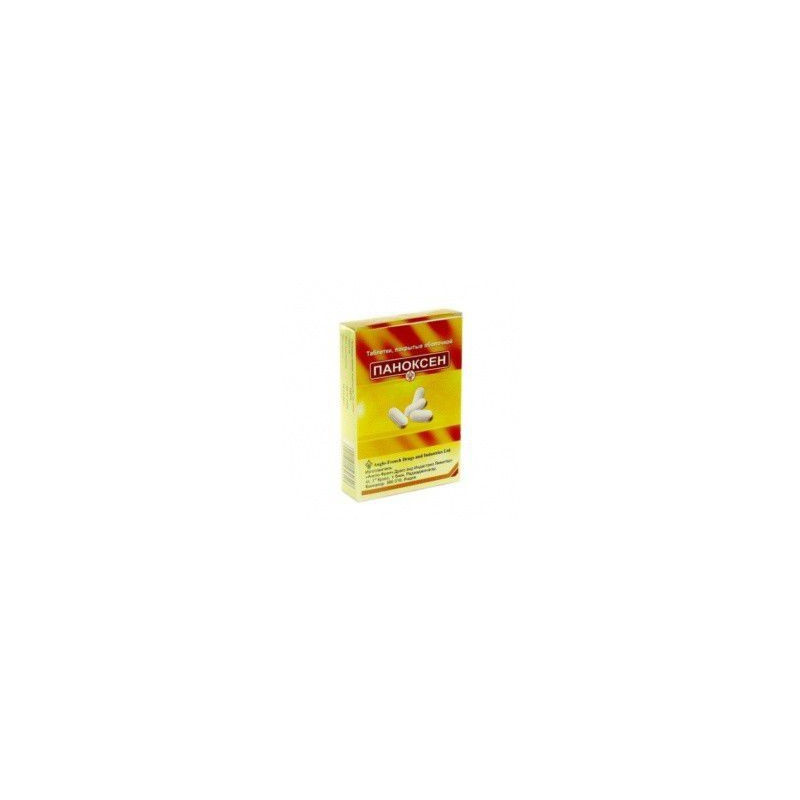



 All payments are encrypted via SSL
All payments are encrypted via SSL
 Full Refund if you haven't received your order
Full Refund if you haven't received your order
20 pieces
PANOKSEN - the combined anti-inflammatory drug. Diclofenac - NSAID, a derivative of phenylacetic acid. Inhibition of COX-1 and COX-2, violates the metabolism of arachidonic acid, reduces the number of prostaglandins in the inflammation and in healthy tissues, suppresses the exudative and proliferative phases of inflammation. It has anti-inflammatory, analgesic, antipyretic, antiplatelet effect. Paracetamol is a non-narcotic analgesic; indiscriminately blocks COX-1 and COX-2 (mainly in the central nervous system), has little effect on water-salt metabolism and the mucous membrane of the gastrointestinal tract. In inflammatory tissues, cellular peroxidases neutralize the effect of paracetamol on COX and COX-2, which explains its lack of an anti-inflammatory effect.
Inflammatory diseases of the musculoskeletal system (rheumatoid, psoriatic, juvenile, gouty arthritis; ankylosing spondylitis); degenerative diseases of the musculoskeletal system (deforming osteoarthrosis, osteochondrosis); lumbago; sciatica; neuralgia; myalgia; diseases of the periarticular tissues (tendovaginitis, bursitis); post-traumatic pain syndrome, accompanied by inflammation; toothache.
Hypersensitivity (includingto other NSAIDs); a combination of bronchial asthma, recurrent nasal polyposis, paranasal sinuses, and intolerance to Acetylsalicylic acid or other NSAIDs (including a history of); the period after coronary artery bypass surgery; CRF (CC <30 ml / min); progressive kidney disease; severe liver failure; active liver disease; hyperkalemia; erosive and ulcerative lesions of the mucous membrane of the stomach and duodenum; active Gastrointestinal bleeding; inflammatory bowel disease; blood disorders; pregnancy; lactation period; children's age (up to 12 years). C Precautions: coronary artery disease, chronic heart failure, cerebrovascular disease, dyslipidemia / hyperlipidemia, diabetes mellitus, peripheral vascular disease, chronic renal failure (creatinine clearance of 30-60 ml / min), ulcerative lesions of the gastrointestinal tract (history), the presence of Helicobactor pylori, hepatic failure induced acute hepatic porphyria, benign hyperbilirubinemia (including Gilbert's syndrome), deficiency of glucose-6-phosphate dehydrogenase; prolonged use of NSAIDs, simultaneous administration of oral GCS (including prednisolone), anticoagulants (including warfarin), antiplatelet agents (including acetylsalicylic acid, clopidogrel), selective serotonin reuptake inhibitors (including citalopram, Fluoxetine, paroxetine, sertraline), ethanol, nicotine; elderly age.
Inside, without chewing, during or after a meal (to achieve a quick effect - 30 minutes before a meal), with a small amount of water, 1 pill (50 mg of diclofenac + 500 mg of paracetamol), 2-3 Maximum daily dose - 3 pills For children over 12 years old, a daily dose of 2 mg / kg body weight (in terms of diclofenac).
Gastrointestinal: often - NSAID-gastropathy (erosive and ulcerative lesions), gastralgia, nausea, vomiting, diarrhea, flatulence, anorexia, increased activity of hepatic transaminases, gastrointestinal bleeding (hematemesis, melena), hepatitis (including fulminant), pancreatitis, colitis (including those complicated by bleeding), exacerbation of ulcerative colitis, exacerbation of Crohn's disease, aphthous stomatitis, glossitis, dry mouth, erosive esophagitis, constipation.
Nervous system: headache, dizziness, fatigue, paresthesia, memory loss, disorientation, reduced visual acuity, diplopia, hearing loss, tinnitus, insomnia, irritability, convulsions, depression, anxiety, nightmares, tremor, psychosis, impaired taste, anxiety, perception disorder, tremor, scotoma, aseptic meningitis.
From the skin: alopecia, photosensitization, erythematous skin rash, angioedema, eczema, pruritus, rash on mucous membranes (erythematous, urticarial).
Urogenital: acute renal failure, hematuria, proteinuria, interstitial nephritis, nephrotic syndrome, papillary necrosis, oliguria, cystitis, renal colic, non-specific bacteriuria.
Hemic and lymphatic: thrombocytopenia, leukopenia, agranulocytosis, hemolytic anemia, aplastic anemia, methemoglobinemia, sulfhemoglobinemia, pancytopenia, neutropenia.
Allergic reactions: bronchospasm, urticaria, Stevens-Johnson syndrome, Lyell's syndrome, allergic purpura, systemic Anaphylactic reactions (including anaphylactic shock), skin rash, bullous dermatitis, erythroderma.
Cardiovascular: arrhythmia, increased blood pressure, palpitations, pain in the chest.
Other: hypoglycemia (including hypoglycemic coma), impotence.
Increases the concentration of Digoxin, cyclosporine, lithium preparations. When taken simultaneously with potassium-sparing diuretics increases the risk of hyperkalemia, with anticoagulants - the risk of bleeding. Reduces the effectiveness of diuretic, antihypertensive and hypnotic drugs. Increases the risk of side effects of NSAIDs, GCS (gastrointestinal bleeding), the toxicity of Methotrexate, cyclosporine nephrotoxicity. When taken with thrombolytic (alteplaza, streptokinase, urokinase) increases the risk of bleeding (usually the gastrointestinal tract).Acetylsalicylic acid reduces the concentration of diclofenac in the blood. With simultaneous use with oral hypoglycemic drugs, hypo-or hyperglycemia is possible. With simultaneous use with cefamandol, cefoperazone, cefotetan, valproic acid, plicamycin, the incidence of hypoprothrombinemia increases. Cyclosporine and gold preparations enhance the effect of diclofenac on the synthesis of prostaglandins in the kidneys, which is manifested by an increase in nephrotoxicity. Simultaneous use with paracetamol increases the risk of the development of the nephrotoxic effects of diclofenac. Simultaneous use with colchicine, corticotropin, preparations of Hypericum, ethanol increases the risk of gastrointestinal complications, accompanied by bleeding. Reduces the hypotensive activity of BCCA, ACE inhibitors. Inductors of microsomal oxidation in the liver (phenytoin, ethanol, barbiturates, rifampicin, phenylbutazone, tricyclic antidepressants) increase the risk of the hepatotoxic effect of paracetamol. Simultaneous long-term use with salicylates increases the risk of developing malignant diseases of the kidneys and bladder. Diflunisal increases the plasma concentration of paracetamol by 50%, increasing the risk of its hepatotoxic action. Prolonged use of barbiturates reduces the effectiveness of paracetamol.
In a dry, dark place at a temperature of no higher than 25 ° C.
Panoxen